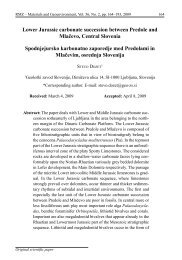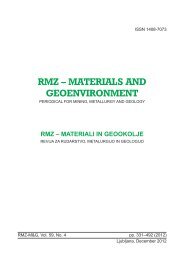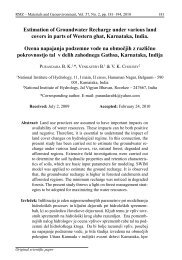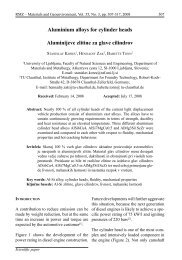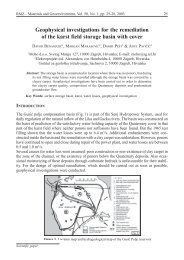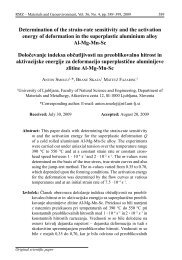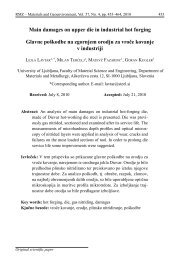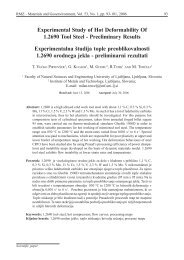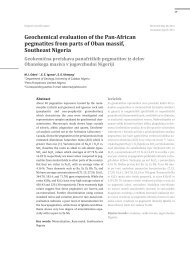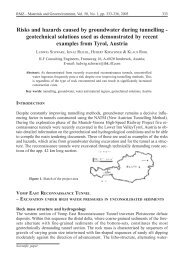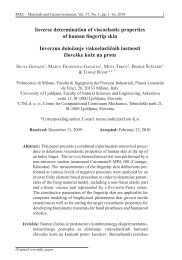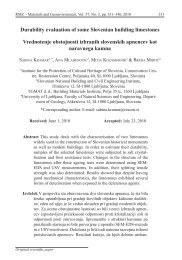Petrochemistry and genetic indicators of talcose rock of Esie ... - RMZ
Petrochemistry and genetic indicators of talcose rock of Esie ... - RMZ
Petrochemistry and genetic indicators of talcose rock of Esie ... - RMZ
Create successful ePaper yourself
Turn your PDF publications into a flip-book with our unique Google optimized e-Paper software.
378 Olorunfemi, A. O., Olarewaju, V. O. & Okunlola, O. A.<br />
chean komatiitic <strong>rock</strong>s, Sun & Nesbitt<br />
(1978) proposed that the sources <strong>of</strong><br />
spinifex textured komatiite must have<br />
originated from a depth greater than<br />
400 km in the mantle. Early melts <strong>of</strong><br />
low degree <strong>of</strong> partial melting may have<br />
concentrated more LREE <strong>and</strong> LIL.<br />
When these melts are separated, the<br />
residual mantle source would probably<br />
be depleted in LREE. There is<br />
no discernible trend in the variation <strong>of</strong><br />
LREE <strong>and</strong> HFSE elements such as Ti<br />
<strong>and</strong> Sc, in the <strong>Esie</strong> <strong>talcose</strong> <strong>rock</strong>s. For<br />
example, when Ti is plotted against<br />
La, Sc <strong>and</strong> Yb (Figure 9a, 9b & 9c)<br />
there is no consistency in all the variations.<br />
Thus, if La, Ti, Yb, <strong>and</strong> Sc abundances<br />
are controlled by partial melting<br />
or simple fractional crystallization<br />
process, a consistent co-variation or<br />
conformity should be observed in the<br />
three elements. However, if the LREE<br />
results from a complex melting process<br />
no consistent variation would be observed.<br />
The REE have been known to<br />
be immobile elements <strong>and</strong> are expected<br />
to reflect the primary petro<strong>genetic</strong> characteristics<br />
<strong>of</strong> fresh <strong>and</strong> unaltered igneous<br />
<strong>rock</strong>s. Some certain trace elements<br />
like Ti, Y, Nb, Zr (Menzies, 1976) are<br />
in general considered to be immobile<br />
during <strong>rock</strong> alteration. However, the<br />
investigations <strong>of</strong> basaltic <strong>rock</strong> samples<br />
by some workers (Wood et al., 1976,<br />
Ludden & Humphris, 1978; Ludden &<br />
Thompson, 1978, 1979) have shown<br />
that in certain situations, especially<br />
during <strong>rock</strong> alterations, the REE are<br />
mobile. Hellman & Henderson (1977)<br />
have also suggested that the LREE may<br />
be mobile also during <strong>rock</strong> alteration.<br />
Hellman et al., (1979) identified the<br />
principal types <strong>of</strong> REE enrichment <strong>and</strong><br />
discovered that to an extent, the most<br />
important problem is LREE or HREE<br />
group mobility or selective mobility,<br />
mainly <strong>of</strong> La, Ce <strong>and</strong> most likely Eu<br />
especially during <strong>rock</strong> alteration or<br />
fractionation. The <strong>Esie</strong> <strong>talcose</strong> <strong>rock</strong>s in almost<br />
all cases show extensive enrichment<br />
(La : Sm) n<br />
= 1.53–5.06, (La : Yb) n<br />
= 3.37–<br />
21.96 relative to chondrite. Arth et. al.<br />
(1977) formulated a unified petro<strong>genetic</strong><br />
model where the tholeiitic <strong>and</strong><br />
the komatiitic series were thought to<br />
be <strong>genetic</strong>ally related simply because<br />
<strong>of</strong> their intimate spatial relationship.<br />
They believe that the tholeiitic melts,<br />
having (La/Sm) n<br />
<strong>and</strong> (Gd/Yb) n<br />
ratios<br />
>1.0, might be the early melts extracted<br />
from a mantle source, characterized<br />
by a flat chondritic REE pattern. The<br />
extraction leads to LREE-depleted nature<br />
in the residue which in turn serves<br />
as the source for some LREE-depleted<br />
komatiites. This could be a plausible<br />
mechanism for LREE depletion, at<br />
least in some <strong>of</strong> the <strong>Esie</strong> <strong>rock</strong> samples.<br />
The extent <strong>of</strong> LREE mobility can also<br />
be shown by the ratios <strong>of</strong> (La : Sm) n<br />
,<br />
(Ce : Sm) n<br />
, (Ce : Yb) n<br />
<strong>and</strong> (La : Yb) n<br />
.<br />
The ratios are given in Table 4. The (Ce<br />
: Sm) n<br />
ratios vary widely, indicating the<br />
Ce mobility. The (La : Sm) n<br />
ratios are<br />
fairly constant, regardless <strong>of</strong> the differ-<br />
<strong>RMZ</strong>-M&G 2010, 57



